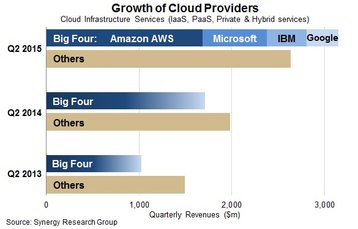Synergy Research Group has released a report showing that Amazon Web Services (AWS), Microsoft, IBM and Google together dominate the public cloud space.
Their combined market share rose to 54 per cent in the latest quarter and their year-on-year revenue averaged 84 percent. In the same quarter the rest of the market grew by 33 percent. While this increase in volume was good for AWS as it keeps its clear lead with 29 percent market share, it was also good for the rest of the market, as Synergy points out, since the Q2 earnings of all major players indicates that average quarterly earnings in this sector are now approaching $6bn.
The surprise of AWS’s continued profitability, with the division’s operating profit up from Q1’s 17 percent to 21 percent in Q2, instantly sparked rumours that loss-making parent Amazon may spin-off the now profitable AWS.
The big four are ahead of the pack
North America accounts for over half of the international market followed by the EMEA and APAC regions.
John Dinsdale, chief analyst and research director at Synergy Research Group said: “The cloud infrastructure services market is quite clearly bifurcating with a widening gap between the big four cloud providers and the rest of the service provider community.
He continued: ”Developing the necessary global hyperscale data center infrastructure along with the required marketing and operations support is simply beyond the reach of all but a very small number of players. This is not going to change. The good news for the plethora of small-to-medium-sized cloud providers is that there does remain a wealth of opportunity for those that are focused on specific market niches or local geographic areas.”
Amazon’s growth is in no small way due to its grip on the public sector in the USA. In June this year The Washington Post said that Amazon held the lion’s share of cloud services to the USA Government as a result of a federal directive which ordered agencies to consolidate their data centers and move to the cloud. Amazon was well-prepared for this move and had already started to build an infrastructure and network of companies with histories of government work.

